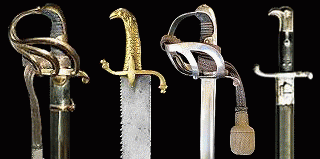Trygve S.

|
Bayerischer Bürgerwehrsäbel
Maier describes weapons of the Bayerischer Bürgerwehr 1790-1806 mainly in his second manuscript/book on edged weapons from Bayern . Although there were as many variations of weapons as there were officers carrying them, Maier divides the Bürgerwehr officer sabres in three categories/patterns :
- First - with big and thick lion’s heads at the end of the Griffkappe (back strap), and with symmetrical Stichblatte (guard). According to Maier, this pattern was the earliest one, originating by an order of “Rumford—Säbeln” from Solingen in 1788 . However, it has not been proved that this first pattern was manufactured after 1800.
- Second - with a less etched mounting with “Rumford Griffkappe” and an excessively broad Griffbügel (knuckle bow), which seamlessly broadens into a Stichblatt.
- Third – with a narrower Griffbügel, and narrower lion’s head compared to the above categories. Also with a cross-piece at the Stichblatt, making the weapons look rather similar to hussar weapons of the era.
The two last categories were in use up until 1825, i.e. until the reign of King Ludwig I (1825-1848). Due to the fact that Bürgerwehr officers purchased their own weapons, it is very difficult to date the manufacture of such sabres precisely, unless they have etchings/ inscriptions giving this away. The hilt of our sabre resembles the hussar weapons of the period 1750-1815. However, the guard is distinctive for the Bayerischer Bürgerwehr / Landwehr sabres. I may be wrong, but to my understanding, Bürgerwehr developed into Landwehr and these terms are used as equivalents from 1807 .
According to Jaroslawski the technical approval stamp, at the throat of the scabbard shown below, was a Bayerischer abnahmemarke, which further proves its Bayerischer provenance. I have not been able to verify for which period(s) this abnahmemarke was used, although we know from Jaroslawski that this approval stamp was (also?) used in the period of Ludwig II (reign: 1913-1915). Since the hilt of the sabre suggests inspiration from the hussar weapons of 1750-1815, this indicates that the scabbard was a replacement, which there are many examples of, if the approval stamp does not correlate to this earlier period.
The black scabbard strongly indicates that the sabre was used by Kavalerie, Schützen or Kanoniere . There are Schützen sabres with very similar examples of Stichblatt . However, the length of the sabre indicates that it was a cavalry weapon, as it would be quite impractical to wear it for anyone moving around on foot, unless they were more than 190-200 cm. tall. The seller of the sabre, in a store for antiques, also said it was a cavalry officer’s weapon from Bayern, although he did not mention anything about the Bürgerwehr provenance.
Although there were exceptions to the Maier’s categorization above, the sabre fits best in the second category. Maier does not mention when the second pattern was introduced, but from the examples he show in his work, I would deduce that it was introduced around 1800. A sabre with similar hilt design, although overall shorter, is identified by Herman Historica Antique Auction House as a Bürgerwehr Offizier Säbel belonging to the period of the reign of Max I. Joseph (1806-1825).
Conclusion:
This sabre is a Bayerischer Bürgerwehr Säbel. It is probably a cavalry weapon and possibly an officers sabre, although then a not so wealthy officer as it has no etching or gilt (Was it hastily produced for employment in the Befreiungskriege of 1813-1814?). It is not easy to verify the year of manufacture, but several indications point to the period 1800-1825, some placing it in the first part of this period.
I have the original text in a Word file with all the sources as end-notes in. For anyone interested, send me a message with an e-mail address and I can send the complete file.
|


 06.10.17, 23:02:20
06.10.17, 23:02:20
 10.10.17, 23:51:27
10.10.17, 23:51:27